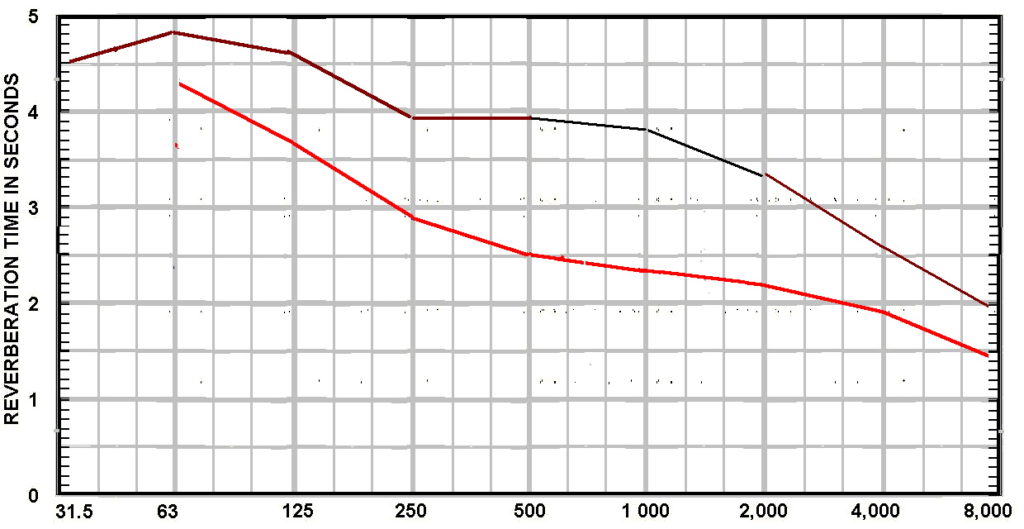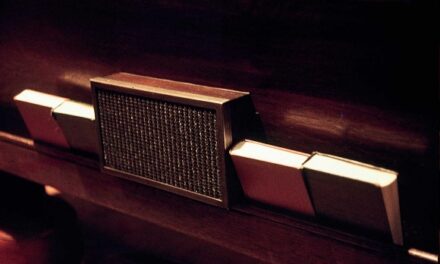Proposed methods to make intricately-painted sound-absorbing acoustic-tile concert-hall, theater, lecture-hall, and worship-space ceilings sound-reflecting
by David Lloyd Klepper
Yeshivat Beit Orot, Shmuel ben Adiya 1, Mt. of Olives, Jerusalem 97400, Israel ddaveklepper1@gmail.com 011-972-51-215-0532
I. INTRODUCTION
Sound-reflecting ceilings are a major component in assuring good natural acoustics in the title’s assembly spaces1. Acoustical “dark-age” architects often did understand this and mistakenly assumed that was good for restaurants and sports venues and libraries would provide good acoustics in these performance and worship venues, to the detriment of these spaces’ usefulness. Removal of the tile and refinishing hard surfaces behind, or covering the tile with hard material heavy enough to reflect low and well as high frequency energy are usual methods in solving the problem.2 But objections to either method occur when the tile has been painted with an intricate and well-loved design that must be preserved. The proposed methods in this paper have not yet been used or experimentally verified, but such experiments need not be expensive and hopefully will be tried and verified by an acoustical expert faced with the problem in the near future.
II. FIRST METHOD
Figure 1 shows the first method. Thin transparent Plexiglas (1/2-nch thick) is used because usually not much weight can be added to the ceiling. Adding the Plexiglas without further measures would provide high-frequency reflections, but low-frequency energy would pass through the Plexiglas to be absorbed by the tile behind and be absorbed by panel-vibration within the Plexiglas.2
The method is to drive nails through the Plexiglas into the wood decking behind with enough force to actually compress the acoustic tile and prevent the Plexiglas from vibrating. Thus, the mass of the total construction will be in effect to reflect low-frequency energy efficiently. If the ceiling construction is concrete, not wood, then holes must be drilled and special concrete bolts used. In any case, the Plexiglass panels must fit the coffers precisely. Tiny holes for the nails must be drilled in the Plexiglass, or driving the nails in may result in fissures destroying transparency. Two or three sample ceiling coffers should be treated, possibly in an easiest-to-reach area. Then, after 18 months, these should be inspected to check that no loosening of the tight installation has occurred. Then the remainder or the ceiling should be treated.
But first, the method should be proved by a mock-up of a full typical coffer measured for sound-absorption in the reverberation chamber of an acoustics testing laboratory. And, although we do not expect any chemical interaction between the painted ceiling tile and the plexiglass, we recommend placing a spare ceiling tile against a piece of the plexiglass for at least a week to confirm that the two do not interact.

Figure 1. First method for effecting acoustic tile to be sound-reflecting
III. SECOND METHOD
The second method should be much easier to apply, but requires more experimentation and development, and success of the development is an open question at the moment. Is there a liquid sealer that can be brush, roller, or spray applied that can penetrate the painted design without destroying it and fill the pores within the acoustic tile?
Around 1910 Raphael Guastavino and Wallace Clement Sabin developed Guastavino tile, later labeled Rumford Tile and Akoustolith, which was a stone-like porous tile used as ceiling material to reduce reverberation in cathedrals and cathedral-like churches. The papers in Reference 3 discuss how the ceiling of St. Thomas Episcopal Church, Fifth Avenue, New York City, was treated to make it sound reflecting, providing a more reverberant environment to benefit the choir, organ, and congregational singing, with the reverberation problem for speech solved by a good sound system. A similar approach was used successfully in the Duke Princeton, and Chicago University Chapels, and the Heavenly Rest and Riverside Churches in New York City. (Acoustical firms included Bolt Beranek and Newman, Kirkegaard Associates, and Klepper Marshall King.). Experimentation with a few pained acoustic tiles and the various sealers applied in these projects should answer the question whether the technique is applicable. And, although we do not expect any chemical interaction between the painted ceiling tile and liquid sealer, we recommend painting a spare ceiling tile with the chosen sealer and observing it for at least a week to confirm that the two do not interact.

Figure 2 Measured change in reverberation time at St. Thomas Church Fifth Avenue, New York, with sealing the Guastavino ceiling tile. Data empty, but with pew cushions.4
References:
1The chapel at St. John Vianney Theological Seminary, Hartville, Ohio is one example.
2M. David Egan, Architectural Acoustics, McGraw-Hill. New York, NY 1988, 98.; Leo. L. Beranek, Concert Halls and Opera Houses, Music Acoustics and Architecture, Academic Press., Springer-Verlag. New York, 2002, 523-527. Available from the Acoustical Society of America. Marshall Long, Architectural Acoustics, Academic Press. New York, 2006, p. 671-674. Second Edition, 2013, p. 299-302. This Website, David L/ Klepper, “Comments on “G,” a measure of loudness, the efficiency of sound transmission from stage to audience in concert halls, an addition to the article on importance of the early-to-reverberant sound-energy ratio, “Clarity,” in speech and music acoustics, related to use of sound-reflecting panels with attention to data in Dr. Leo L. Beranek’s three concert-hall books.” Mendel Kleiner, David L. Klepper, and Rendell Torres, Worship Space Acoustics, J. Ross, Fort Lauderdale, Florida (2010). www.jrosspub.com, p. 42 – 55
3David L. Klepper, The Acoustics of St. Thomas Church Fifth Avenue”, Journal of the Audio Engineering Soc. 43:7/8, 99-601 (1995), also Sound Reinforcement Vol 2, Audio Engineering Society, New York, 1996, pp. 392-394 (This is the reference with a list of the products used successfully for the Guastavino application); Craig. Whitney and Daniel Clayton, 147th Meeting, 75th Anniversary, Organ Recital (program). Acoustical Soc. of Am, Melville, NY, p. 1, (2004); This Website, David L. Klepper, “Comments on “G,” a measure of loudness, the efficiency of sound transmission from stage to audience in concert halls, an addition to the article on importance of the early-to-reverberant sound-energy ratio, “Clarity,” in speech and music acoustics, related to use of sound-reflecting panels with attention to data in Dr. Leo L. Beranek’s three concert-hall books;” Mendel Kleiner, David L. Klepper, Rendell Torres., Worship Space Acoustics, J. Ross, Fort Lauderdale, Florida (2010). www.jrosspub.com, p. 163, 280
About the Author
David Lloyd Klepper is currently a student of Rabbinics at Yeshivat Beit Orot, Jerusalem, Israel, having moved to Israel in 1996 from his position as President of Klepper Marshall King, White Plains, NY, Acoustical Consultants, and as Adjunct Professor of Architectural Acoustics at City University, New York City. Before 1971 he was a senior consultant at Bolt Beranek and Newman, starting his consulting career there in May 1957. He received his SM and SB degrees in Electrical Engineering from MIT, and between times served as Assistant Audio-Radio Member of the PsyWar Board at Fort Bragg, NC, during the Korean conflict, leaving active duty as a 1st Lt. He provided acoustical advice for over 200 worship space buildings, including the National Presbyterian Church, Washington, DC, St. Thomas Church Fifth Avenue, New York City, the Capetown, South Africa, Anglican Cathedral, River Road Baptist Church, Richmond, Virginia, Young Israel of Southfield, Michigan, and Boston’s Holy Cross Cathedral. In this capacity, he was a pioneer in application of digital delay and electronic simulation of reverberation in worship spaces, and pew-back speech reinforcement. Publications include 40 papers in professional journals, a coauthor with Professor Kleiner and Father Rendell Torris of the book Worship Space Acoustics, JRosspub.com., and Editor of the two Sound Reinforcement Anthologies of the Audio Engineering Society. He is a fellow of both the Acoustical Society of America and the Audio Engineering Society, past Emeritus Board Certified member of the Institute of Noise Control Engineering, and a member of both the American Guild of Organists and the Organ Historical Society. He also belongs to a number of railroad and public transit interest organizations. You may contact Klepper at ddaveklepper1@gmail.com.



